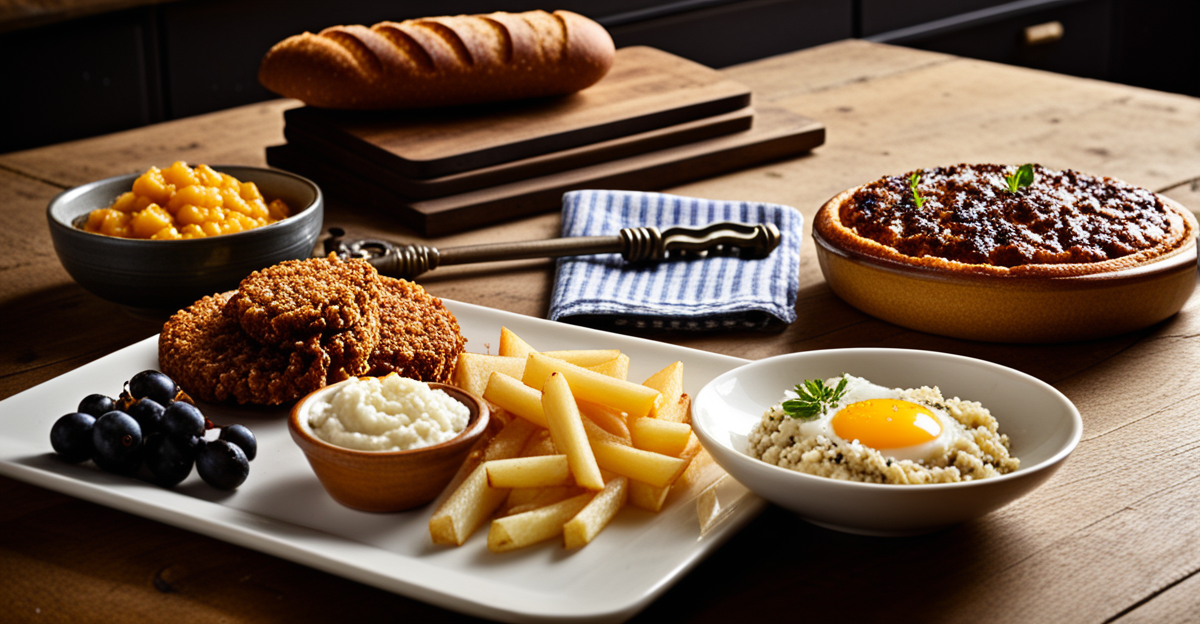Common Ingredients in Traditional British Cooking
A defining feature of British cuisine is the reliance on essential ingredients that have stood the test of time. These staples vary from dairy products and grains to seasonal produce, each playing a crucial role in the nation’s culinary identity.
The importance of seasonal produce cannot be overstated in traditional British cooking. Crops like carrots, cabbage, and potatoes dominate the landscape, thriving in the temperate climate. Utilizing these at their peak of freshness not only enhances the flavor but aligns with the practice of sustainable living, reducing food miles in the process.
Also to read : How do you make a traditional Eton mess with a modern twist?
Traditionally, British cooking leans heavily on dairy and grains. Dairy products such as cream, milk, and cheese are not only key to the texture and flavor of many dishes but also add nutritional value. Dairy is often used in combination with grains like wheat and oats, essential components in the preparation of classic foods like bread, porridge, and crumbles. These ingredients weave a comforting fabric of nourishment that echoes through generations.
Grains form the backbone of many meals, impacting both the structure and presentation of dishes. They have a longstanding presence in daily British diets, reflecting a preference for hearty, wholesome food choices. As such, understanding these core elements provides a window into the heart of British gastronomy.
Topic to read : Discovering Traditional British Dishes: What Ingredients Are Key in Their Recipes?
Key Flavorful Herbs and Spices
British cuisine, although historically understated in its use of herbs and spices, incorporates a selection of aromatic agents that are pivotal to adding layers of flavour to traditional dishes. Understanding these herbs and spices is essential to mastering the nuanced British culinary arts.
Commonly Used Herbs in British Cuisine
Fresh herbs, such as parsley, thyme, and rosemary, are staples in British cooking. They brighten up heavier dishes like stews and roasts with their vibrant aroma. Parsley is particularly versatile, often employed in sauces and garnishes. Thyme, with its earthy scent, pairs excellently with meats and vegetables, while rosemary’s robust profile enhances roasted meats and potatoes.
Spice Blends and Unique British Flavours
Though British cuisine is modest in spice, unique blends like English mustard and Worcestershire sauce integrate key spices like coriander, cumin, and black pepper, creating distinct tastes. Worcestershire sauce, a fermented liquid condiment, balances savoury dishes with its intricate blend, including tamarind and anchovies. While not a traditional spice blend per se, these complements add complexity to recipes ranging from cheese toasties to Shepherd’s Pie.
Seasonal Herb Availability and Freshness
Using herbs at their peak season ensures maximum flavour. Spring and summer see an abundance of mint, dill, and chives, perfect for salads or dressings. To ensure freshness, locally sourced herbs should be your go-to. Keeping a small herb garden is another practical solution, allowing home cooks to draw on fresh resources year-round, which is particularly beneficial during the winter when fewer herbs are naturally available. Selecting the right herbs and spices not only enriches British recipes but complements their hearty textures and flavours seamlessly.
Proteins in Traditional British Dishes
Delving into British cuisine, it’s evident that protein sources play a pivotal role in shaping classic dishes. Traditional meals often revolve around hearty, protein-rich ingredients that have been cherished for generations.
Types of Meat: Beef, Lamb, and Pork
In British cooking, beef, lamb, and pork are celebrated staples. Beef often features in Sunday roasts and stews, providing robust flavor and rich nutrients. Lamb, with its tender texture, finds a place in dishes like lamb chops or mint-infused roasts, cherished for its distinct taste. Meanwhile, pork is versatile, from sausages to belly roasts, embodying comfort and satisfaction.
Poultry Choices: Chicken and Duck
Chicken remains a beloved staple, adaptable to numerous dishes from pies to casseroles, appreciated for its subtle taste and ease of cooking. Duck, with its richer profile, is favoured in gourmet fare, offering a unique depth of flavour when roasted or glazed, highlighting the sophistication inherent in British cuisine.
Plant-Based Proteins: A Growing Trend
The rise of plant-based proteins is reshaping traditional cooking. Ingredients like lentils and chickpeas provide nutritious alternatives, often incorporated into pies or stews, reflecting a shift towards more sustainable and health-conscious eating. As these plant-based choices gain traction, they challenge and expand the limits of traditional recipes, ushering in a modern adaptation while respecting culinary heritage.
Essential Vegetables for British Recipes
Vegetables play a significant role in traditional British cooking, bringing not only nutritional value but also vitality and color to numerous dishes. The rich tapestry of British cuisine is woven together by a selection of essential vegetables, each bringing its distinct character to the table.
Common Vegetables and Their Uses
In British cuisine, root vegetables like potatoes, carrots, and parsnips take center stage. These hearty options form the backbone of dishes such as Sunday roasts and hearty stews. The humble potato is perhaps the most versatile, finding its way into everything from mashed potatoes to crispy roasties, highlighting its adaptability and essential nature. Cabbage and Brussels sprouts, often enjoyed blanched and buttered, are staples for festive meals and everyday sides alike.
Seasonal Availability and Sourcing Tips
Utilizing seasonal produce is intrinsic to traditional British cooking. Springtime sees the arrival of asparagus and spring onions, often paired in salads or as side dishes. As the seasons progress into summer, peas and broad beans become more prevalent, enriching the freshness of warm-weather meals. To maximize flavour and sustainability, sourcing vegetables from local farmers’ markets or growing them in personal gardens is highly recommended. This practice not only supports local agriculture but ensures the freshness and integrity of the ingredients used in home cooking.
Cultural Significance of Certain Vegetables
Certain vegetables hold a cultural resonance within British cuisine. The turnip, for example, is often associated with hearty Scottish dishes, while leeks are emblematic of Welsh heritage, showcasing the regional diversity and historical ties embedded in these staples. By weaving these vegetables into daily cooking, one preserves and celebrates the rich traditions and flavours that define British culinary history.
Dairy Products: The Cornerstone of British Cuisine
Dairy products form the backbone of British culinary tradition, influencing both taste and texture across a variety of dishes. These traditional ingredients bring richness and depth, playing a crucial role in the nation’s cooking landscape.
Cheeses: Types and Uses
In the realm of British cheese, diversity is key. Cheddar stands out as a quintessential choice, its strong flavor frequently enhancing dishes ranging from sandwiches to sauces. Stilton adds a touch of sophistication with its tangy, crumbly profile, often featured in salads or served with port. Lancashire cheese, known for its crumbly texture, finds its place in savory pastries like the classic cheese and onion pie. These regional cheeses not only enrich recipes but also reflect the rich history and culture of British cheesemaking.
Cream vs. Milk: When to Use Each
Cream and milk serve distinct purposes in British cuisine. Cream, with its higher fat content, is essential for adding richness to desserts like Eton Mess or savory dishes like beef stroganoff. It brings a silky texture and a luxurious mouthfeel, transforming ordinary recipes into indulgent experiences. Milk, on the other hand, is versatile and often used to provide moisture and softness in baking or to balance flavors in soups and sauces. Understanding the appropriate use of each can markedly enhance culinary outcomes.
Butter and Margarine: In Cooking and Baking
Butter, with its unmistakable flavor profile, is a staple in British baking and cooking. It lends flakiness to pastry, enriches sauces, and serves as a base for roux in dishes like Macaroni and Cheese. In contrast, margarine offers a budget-friendly alternative and is often chosen for its lower saturated fat content, though some argue that it lacks the distinct richness of butter. Both fats have their place, with the choice depending on dietary needs, cost considerations, and the desired outcome of the dish.
Grains and Carbohydrates in British Cooking
Grains and carbohydrates form the backbone of many cherished British dishes, playing a crucial role in the structure and composition of meals. In the context of British cuisine, these ingredients are foundational, serving as the primary energy source and providing the bulk of sustenance in daily meals.
Traditional grains, such as wheat, oats, and barley, are integral to British cooking. Wheat is predominantly used in breadmaking, providing the essential base for sandwiches, toast, and more. Oats, renowned for their nutritional value, are featured in hearty porridge—a staple breakfast offering warmth and sustenance. Barley, often used in soups and stews, adds texture and a subtle nutty flavour to recipes.
The choice of grains strongly influences meal structures. In classic British dining, grains are used to create filling and nourishing dishes. For instance, a well-crafted pie with a pastry crust of wheat flour or an oat-rich serving of porridge underscores a commitment to wholesome eating. These grain-based foods often play a secondary yet significant role in supporting proteins and vegetables, providing balance and complementing the diversity of flavours.
In recent years, health trends have prompted an exploration of alternative grains, such as quinoa and spelt, emphasising their nutritional benefits over traditional options. While these alternatives have become popular, traditional grains remain a staple, cherished for their versatility and ability to anchor meals firmly in the cultural context of British gastronomy.
Iconic Traditional British Dishes
Exploring the world of classic British recipes reveals a rich history rooted in tradition and cultural significance. Each dish tells a story, using staple British cooking ingredients renowned for their simplicity and depth of flavour.
Fish and Chips: Ingredients and History
The quintessentially British dish, fish and chips, pairs crispy battered fish with golden fries. Traditionally made with cod or haddock, the fish is coated in a flour-based batter and deep-fried to perfection. This meal became widespread in the 19th century, tied to the rise of trawl fishing and railways. A favourite takeaway, the dish reflects Britain’s maritime past and working-class heritage.
Shepherd’s Pie: A Comfort Food Staple
Shepherd’s Pie is a revered comfort food in British cuisine, known for its hearty and warming qualities. It consists of minced lamb enveloped in a rich gravy, topped with creamy mashed potatoes. A variant using beef is called Cottage Pie. This dish is often prepared in a single baking dish, ideal for family gatherings, demonstrating the essence of homestyle cooking.
Roast Dinner: The Traditional Sunday Meal
The traditional Sunday Roast is a much-loved tradition in British households. Centered around roasted meats such as beef, lamb, or chicken, it includes a variety of sides like roast potatoes, seasonal vegetables, and rich gravies. Yorkshire pudding often accompanies roast beef. This meal exemplifies British culinary rites, linking families through shared weekend rituals and hearty flavors.
Incorporating these iconic meals into home cooking allows one to savor the deep-seated culinary heritage of Britain. Each dish, steeped in history, not only satisfies the palate but also nurtures a connection to the cultural roots and shared dining experiences.








